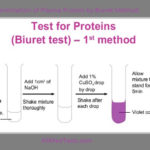PFF or Protein Free Filtrate preparation is one of the most practiced tests in biology labs. In this test, protein is completely removed from the blood to make different observations. There is some really nice and deep search behind this test which is being used for many purposes. For the biology, students it is important to have a good understanding of this test. Most of the guide available on the internet for Protein Free Filtrate test might be complex. Today, I am going to teach you an easy and quickest method to perform this test. Make sure that you are reading everything with good care and you are not missing anything. We are also going to discuss the best method for PFF and why is this test conducted. So let us now move with our procedure of Protein Free Filtrate test by Folin and Wu.

Why Protein Free Filtrate is necessary?
Before performing any test, students need to know that why a certain test is performed. Without know the reason for the test, we might see student’s lack of interest when he has no idea what he is doing? That’s why I am going to explain why is this test conducted in the first place?
Well, there are many blood carried out in labs and many of them cannot be performed well if protein is present in the blood. Protein has the tendency to interfere with many things during these tests and that’s why removing it from the blood is very necessary. That is the reasons why these PFF tests are performed including precipitation by anions and Folin Wu method. In this article we are going to do it through the 2nd method mentioned. Let us now perform this test to get PFF.
Protein Free Filtrate by Folin Wu Method Principle and Reagent:
In this test, the principle is quite the same as when we precipitate it by anions. Folin Wu method is an advanced form of the test in which the acid which is being used in the test is tungstic acid. Also, the reagent used in the test is prepared by using many elements which I am going to mention ahead. As for principle in this test, we precipitate blood by the anions and thus, we remove proteins from the blood. Let us now talk about the preparation of the reagent.
Being a science student, you must know that reagents are always necessary to perform these biological tests. Many elements combine to form the reagent for this test including blood, sodium tungstate, sulfuric acid, potassium oxalate crystal, and distilled water. Mixing these chemicals in the right proportion will prepare a reagent necessary to perform this test. One element sulfuric acid is necessary because it helps in the conversion of sodium tungstate into tungstic acid which is very important for this test. The 2nd reason being, that sulfuric acid has the tendency to break RBCs which helps in the formation of dark brown color from dark red. These two reasons make sulfuric acid an important element in this test.
Procedure for Preparing Protein Free Filtrate:
Let us now walk you through the procedure of preparing Protein Free Filtrate. Make sure that you follow each and every step carefully and you will be done within a matter of seconds.
- Our blood sample will be 2ml in quantity so take it first.
- Next step will be the transfer of this blood sample into a container which contains potassium oxalate.
- Our next step in the step will be to dilute this blood sample with the help of distilled water. So, add 14ml of distilled water in the blood sample.
- From 10 percent sodium tungstate we took, add 2 ml in the solution.
- Then add 67 percent sulfuric acid which is 2/3 in the solution.
- If the test is going right, the color of the solution must change from dark red to dark brown.
- Use any good filter paper to filter this solution.
- Once the filtration is done, a colorless PFF is obtained which confirms a successful test.
Precaution:
Taking useful precautions are very important to perform any test. We have some precaution which must be taken before and during this test.
- Sulfuric acid could cause burns and injuries so make sure that you pour it carefully.
- Make sure that filtration is done carefully. Also, the color of the solution must be observed carefully.
- Take all measurements during the test very carefully to ensure their right amount.
Once you have taken care of all these precautions, your test will be a successful one which will be a colorless PFF.
Final words from Protein Free Filtrate by Folin Wu Method:
Was this test article helpful? If yes, then don’t forget to leave us your feedback about the article. You can ask any question in the comments section below along with feedback. Keep visiting All Med Tests for more biological tests.






HOW MUCH POTTASIUM OXALATE CONTAINS IN THE CONTAINER
will update the post.
Very nice information.
I just want to know the quantity of potassium oxalate to prepare protein free filtrate
This has helped. Thanks